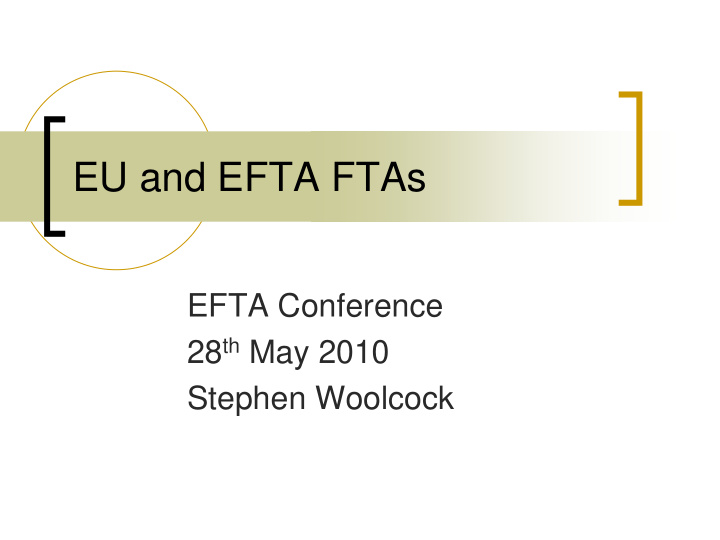



EU and EFTA FTAs EFTA Conference 28 th May 2010 Stephen Woolcock
Overview � Evolution of FTAs � Motivations � FTA and multilateralism � Overall approaches � Content of the EFTA and EU FTAs � Prospects
Evolution of policy � Four phases 1990 -95 EFTA following EU in agreements with � CEECs 1995 – 1998/9 EU and EFTA agreements with � Mediterranean and Middle Eastern countries 1999-2007 Divergence as EFTA pursues more � offensive policy and EU has de facto moratorium on new FTAs 2007 – convergence again as EU reengages � and both EU and EFTA seek FTAs with large Asian partners
Motivations EU has tended to have multiple objectives � European security broadly defined � Also vis-à-vis the south and Med. � Development motives due to legacy of Lome and colonies � Political/foreign policy � Commercial (growth potential) � Promotion of regional integration � EFTA motives � Essentially commercial/economic motives � Prevent trade diversion and gain first mover advantages �
FTAs and multilateralism � Lack of progress in WTO one factor behind growth in bilateral FTAs � Shift began (1995) 2000/1 � EU and EFTA FTAs compatible with Art XXIV GATT and Art V GATS � Broadly building blocs but some WTO-plus provisions (IPR) � FTAs reduce incentives for WTO, but multiple FTAs erode preferences
Overall approach � Broadly similar approaches � seeking to conclude deeper, more comprehensive 2 nd generation FTAs � relatively flexible � Unlike US with NAFTA model � Less than US ‘Gold Standard’ � more commercially oriented (applies mostly to EU)
Content � Tariffs EU � near 100% for coverage of goods � significant coverage of agriculture (EU – Korea � perhaps exception) fairly fast liberalisation (with three years for most) � EFTA � near full coverage for goods � agriculture commodities separate agreements less � liberalisation slightly slower liberalisation (e.g. Korea) �
TBT/SPS cannot be removed by an agreement � needs continuous effort � EU � TBT and SPS basis but WTO plus on procedures � e.g. Korea TBT sector provisions (working groups, specific � standards, mediator, fast dispute settlement EU – Chile detail on how to apply equivalence and � regionalisation EFTA � WTO commitments and obligations and general provisions � promoting int. standards and mutual recognition
Trade remedies � Anti-dumping, safeguards and countervailing duties � Both EU and EFTA rely on WTO provisions on these � Retain rights and obligations � EFTA agreements have review of AD and safeguards after 5 years � Generally shorter periods for bilateral safeguards (e.g. 1-3 years)
Public procurement � 6% of GDP outside of GATT but plurilateral GPA � Both EU and EFTA base FTA rules on the GPA � EU has achieved some GPA-plus commitments with Korea (build-to-lease and sub-central procurement) � EFTA appears to be just GPA commitments
IPR � Important for European producers � EU and EFTA require compliance with existing conventions (TRIPs, Bern, Rome etc) � EU – Korea first FTA since Global Europe policy on effective enforcement of IPRs � EU – Korea TRIPs plus in a few areas , e.g. GIs register for wines and spirits and agri- foods; also criminal enforcement
Services � EU and EFTA use GATS approach (+ve listing except for with NAFTA parties) � Generally GATS plus commitments � Few exceptions on EU or EFTA side in modes 1-3; (education, health, transport) some real estate in new EU member states and EFTAns
investment � Partially covered by GATS mode 3 � EFA has been more ambitious EFTA Singapore comprehensive (definitions, � pre-establishment national treatment, de facto expropriation, investor – state dispute settlement (ICSID) � EU limited by lack of EU competence before Lisbon � Treaty freedom for capital movements (was EC � competence)
Dispute settlement � Both EU and EFTA moving to adopt WTO type dispute settlement � Detailed provisions � Arbitration panels
Sustainable development � Labour standards and environmental provisions � EU has included core labour standards in FTAs (CARIFORUM and Korea), comply with those ratified; for Korea ILO type peer review to promote enforcement and standards � EFA has no substantive provisions
Institutional provisions � Both use Joint/trade Committees � Increasing use of sub-committees and working groups � EU – Korea is a case in point
Summing up � EU and EFTA have had similar FTA policies � Period of divergence during 2000s now coming to an end � EU broader objectives but seeking to become more commercially oriented � Content is broadly similar; although EU Korea is more comprehensive than existing EFTA FTAs
Recommend
More recommend